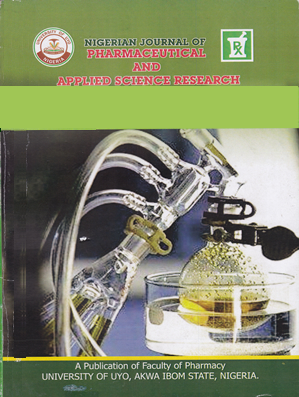Hepatocellular and renal effect of Gongronema Latifolium leaf extract on Albino rat following acetylaminophen (Paracetamol) poisoning
Contenu principal de l'article
Résumé
Background: Gongronema latifolium has been known over the years to serve as cancer preventing agent. The Effect of Gongronema latifolium leaf Extract on Renal and Hepatic tissue of Albino Rat following Acetaminophen (paracetamol) Poisoning was analyzed in this study.
Methods: Twenty eight rats were randomly selected and shared into seven groups of four rats per cage and labeled A,B,C,D,E,F, and G. Cages A, B and C served as both baseline (positive control, and negative control) while group D to G serve as treatment groups (they were treated with both leaf extract in order of 6,12,18 and 24mg/kg weight and 250mg/ml of paracetamol with regards to the LD50. The animals were fed with standard pellet and tap water for 28 days. The doses were orally administered for 28 days. On day 28, the rats were weighed, sacrificed by cranial dislocation, and the liver and the kidney were harvested. The liver and kidney were processed, stained for light microscopy.
Results: Histology of the liver and kidney showed few areas of cystically dilated tubules, focal infiltration of inflammatory cells, mild dilation, extensive tubular dilation , hepatic cytoplasmic clearing, periportal inflammation. Conclusion: This research therefore demonstrated that Gongronema latifolium leaf extract has antioxidative property that enables gradual repair of damaged tissues possible.
Téléchargements
Renseignements sur l'article

Cette œuvre est sous licence Creative Commons Attribution - Pas d'Utilisation Commerciale - Pas de Modification 4.0 International.
Références
Morebise O, Fafunso MA, Makinde JM, Olayide OA, and Awe EO. Antiinflammatory property of the leaves of Gongronemalatifolium. Phytother.Res. 2002;16: 575-S77.
Ugochukwu NH, Babady NE, Cobourne M and Gasset SR. The effect of Gongronemalatifolium extracts on serum lipid profile and oxidative stress in hepatocytes of diabetic rats. J. Biosci. 2003; 28(1): 1-5.
Latunde-Dada GO. Effects of processing on iron levels and availability from Nigerian vegetables. J. Sci. Food Agric.1990; 53(3): 355-361.
Mensah JK, Okoli RI, Ohaju-Obodo JO and Eifediyi K. Phytochemical, nutritional and medical properties of some leafy vegetables consumed by Edo people of Nigeria. Afr. J. Biotechnol. 2008;7(14): 2304-2309.
Nwinyi OC, Chinedu NS and Ajani OO. Evaluation of antibacterial activity of Pisidiumguajava and Gongronemalatifolium. J. Med. Plants Research 2008; 2(8): 189-192.
Akuodor GC, Idris-Usman, MS, Mbah CC, Megwas UA and Akpan JL. Studies on anti-ulcer, analgesic and antipyretic properties of the ethanolic leaf extract of Gongronemalatifolium in rodents. Afr. J. Biotechnol. 2010;9(5): 2316-2321.
Ogbebor NO, Adekunle AT and Enobakhare DA. Inhibition of Colletrotrichumgloeosporioides (Penz) Sac. causal organism of rubber (Heveabrasiliensis Muell. Arg.) leaf spot using plant extracts. African Journal of Biotechnology 2007;6(3): 213-218.
De Madureira MDC, Martins, AP, Gomes M, Paiva J, da Cunha AP, and do Rosario A. Antimalarial activity of medicinal plants used in traditional medicine in S. Tome and Principle Islands. Journal Ethnopharmacology. 2002; 81: 23-29.
Masaba SC. The antimalarial activity of Vernoniaamygdalina Del (Compositae). Trans. R. Soc.Trop. Med. Hyg. 2002;94(6): 694-695.
Tona L, Cimanga RK, Mesia K, Musamba CT and de Bruyne T. In vitro antiplasmodial activity of extracts and fractions from seven medicinal plants used in the democratic republic of Congo. Journal Ethnopharmacalogy. 2004; 93(1): 27-32.
WHO . “WHO global atlas of traditional, complementary and alternative medicine,’’ in Map Volume edition. 2005(Geneva, Switzerland:World Health Organization)
Anthony MP, Burrows, JN, Duparc S, Moehrle J, Wells TN. The global pipeline of new medicines for the control and elimination of malaria. Malar Journal. 2012 7 :316.10.1186/1475-2875-11-316
WHO. National Policy on Traditional Medicine and Regulation of Herbal Medicines. Report of a World Health Organization Global Survey. Geneva, Switzerland: 2005b WHO.
Nwangwu SCO, Nwangwu UC, Josiah JC and Ezenduka C. Hepatoprotective and hypolipidemic potentials of aqueous and ethanolic leaf extracts of Gongronemalatifolium on normal male rats. Asian journal of Biological Sciences 2011.4: 540-547.
Ghanem CI, Pérez MJ, Manautou JE, Mottino AD. Acetaminophen from liver to brain: New insights into drug pharmacological action and toxicity. Pharmacology Research. 2016; 109:119-31
Achukwu PU, Omorodion NT, Erabor, T, Henry EA, Eze, C and Okoyeocha OME. “Codeine and its Histopathological Effect on Brain of Albino Rats: An Experimental Study”. Acta Scientific Nutritional Health. 2019; 3: 125-133.
National Research Council (NRC). Nutrient requirements of fish and shrimp. Aquaculture International. 2012;20 (3): 601–602 .
Eleyinmi AF. “Chemical composition and antibacterial activity of Gongronemalatifolium,” Journal of Zhejiang University. Science B.2007; 8:352–358, 2007.
Wing Sze SC, Tong Y, Ng TB, Yin Cheng CL and Cheung HP.“Herbaepimedii: anti-oxidative properties and its medical implications. 2010; 15:7861–7870
Lai, Q. Wen, L. Li, H. Wu, and X. Li, “Antioxidant activities of water-soluble polysaccharide extracted from mung bean (Vignaradiata L.) hull with ultrasonic assisted treatment,” Carbohydrate Polymers, vol. 81, no. 2, pp. 323–329, 2010.
Nwaogu LA, Alis CS, Ibegbulem CO and Igwe CU. Phytochemical and antimicrobialactivity of ethanolic extract of Landolphiaowariensis leaf. African Journal of Biotechnology . 2007;6 (7): 890-893.


